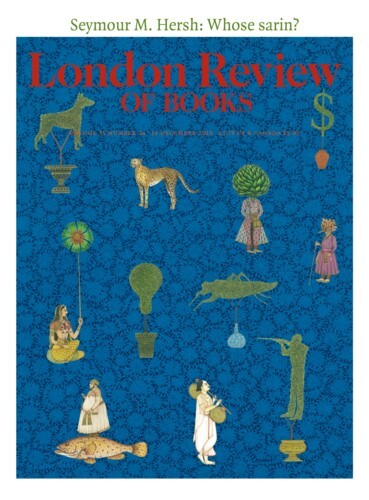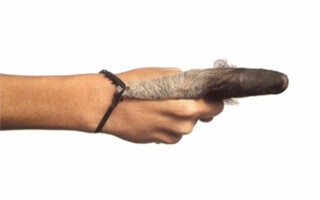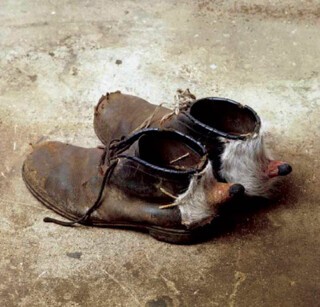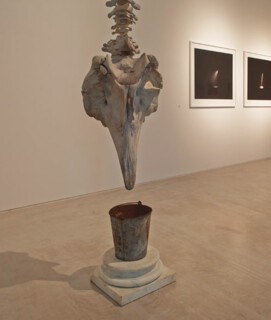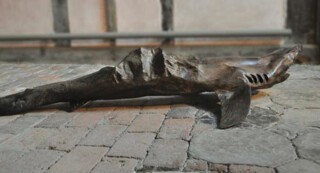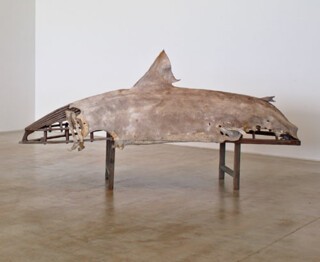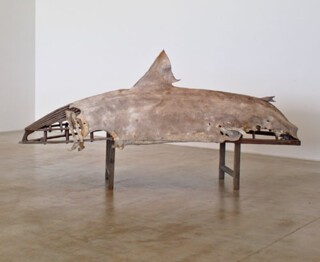When the queen came to Ireland in May 2011 a number of the great, good and merely deserving were locked in the 1937 reading room of Trinity College Dublin for two hours without their mobile phones, before being allowed into the beautiful Long Room of the Old Library to await her arrival. The ratio of men to women was about the same as you find at the front of the plane – five to one perhaps, of suit to skirt – and the conversation veered towards the kind of disaster that happens when Wives Are Not Invited. (‘And what kind of books do you write?’ said some guy, who was in charge of something. ‘Prose fiction,’ I said. ‘Ah …’ he said.) What a pleasure then, to happen on the artist Dorothy Cross, and to admire, with her, the broad backs of the Special Branch men, their triangular napes and the way the curling wires of their earpieces stretched and relaxed against the skin of their necks. One of Cross’s most delicate works is a series of photographs of rugby players in the act of either catching or releasing a ball: it is hard to tell which, and this doubt makes the ball seem, by the end of the sequence, more eggshell than leather.
It wasn’t long before we were discussing the glass penis Cross had blown for her in the furnace of the Waterford Crystal factory, for a piece she called Freud’s Couch, and the difficulties of working with something so fragile. Waterford glass, along with Connemara marble, was one of the dream materials of the Irish state, and Waterford Crystal was up there, in my youth, with the Ardnacrusha hydroelectric station and the lovely girls of Aer Lingus, as providing a vision of an Irish future that was both glamorous and authentic. So it was a completely subversive thing to do, to make a penis out of this stuff, though I am not sure Cross thinks in those terms. Where I see the history of Irish national optimism, Dorothy Cross sees glass, or also sees glass, and it is this playful refusal of accumulated meaning that allows her, perhaps, to get away with it.
Cross lives at the end of a very Irish road, out beyond Oughterard, through the Inagh Valley. This is a famous slice of scenery: you pass the beautiful abbey at Kylemore, until recently a school for middle-class girls, and then avoid the industrial school of Letterfrack, with its unmarked grave for delinquent boys, who were abused by the Christian Brothers in a town that turns its back to the sea. As I drive along this road, the weatherman on the radio promises a day ‘bog agus gaolach’: soft and windy, or, as translated half an hour later, in the English language forecast, ‘blustery, with some drizzle’. I can’t believe this road. It was my parents’ idea of a holiday just to drive along it, or the Sky Road near Clifden, or along the Ring of Kerry. So much time was spent, in our childhoods, getting excited by the beauty of the bog. It is not a substance I could ever mention in a book: too sacred, too overworked, it will, besides, never be mine. I may have saved turf; I may have cleaned the dust of it from my navel after a day of lifting and stacking, harvesting ground that is my uncle’s and was my grandfather’s before him, but I had, let’s face it, a different future ahead of me. You can look like a postcard coleen (some days there was, indeed, a donkey involved) but that doesn’t mean you can be the real thing. I was a city girl on my holidays. I was not going to spend the rest of my life Stuck Down on the Bog.
It was as a coleen, mind you, that I won my first ever writing prize. The Milk Competition was run annually in schools for an essay called ‘The Story of Milk’. This task was made more complicated, somehow, by the fact that I pulled the stuff, every summer, out of a stoical cow called Blue Tits, who was the lieutenant of my uncle’s herd (a nice old thing, she was the colour of Stilton cheese).
Dorothy Cross’s early works, made out of cow’s udders, were transgressive and Irish, funny and transformative. The teats were both phallic and female, the play of penetration and nurture at its most topological in a work called Pointing the Finger, where the teat is turned into one of those condom-like bandages lucky girls got to wear if they hurt their finger at school. There are 22 of these works and they attracted the attention of the art market, in the early 1990s, in a way that made Cross uncomfortable. She realised that she could become successful in a particular way if she confined herself, for the rest of her life, to working with udders.
Her art, since then, has been increasingly hard to commodify. Cross likes to look at bodies in the landscape or in water, and to work the line where the land meets the sea. The 1999 work Ghost Ship put a luminous lightship into Dublin Bay, which glowed and faded in the dark. In 2005 she staged Pergolesi’s Stabat Mater inside a cave on the small Irish island of Valentia. This sense of singing in the wilderness is at its most moving in Selam, in which an elderly shark-caller in New Ireland, Melanesia, weeps as he records, for her camera, a lost hunting song.
‘Beer. Books. Eggs. Marble. Wool’. This is the sign painted on the gable of Joyce’s craft shop at Recess, before the turn-off to Letterfrack. Connemara is an impossible place. The only way I can cross this countryside is by recourse to the English writer Tim Robinson, a cartographer and artist who cures the Irish nostalgia for landscape – that heart-sickness – by describing it in great detail, excavating the stories under every field and wall. The castle at Kylemore, with its ‘Tennysonian’ vistas, was built by an English cotton magnate. It is now occupied by Benedictine nuns whose forebears fled the town of Ypres in 1914. The estate at Letterfrack was developed by a Quaker called Ellis, who made his fortune in the mills of Bradford. As a result of his benign management, the community lost only one tenant in the famine years to 1851 while the larger neighbouring estate lost nearly seven hundred. Dorothy Cross’s studio is in Renvyle, where Yeats went on honeymoon and his new wife talked to a ghost called Athelstone Blake. There is nowhere, in this landscape, where a writer of prose fiction can rest her eyes.
Cross has worked in Papua New Guinea and under the ice of Antarctica and I wonder what brings her back to this place, where she has bought a small piece of land beside the sea. She seems to like it. She does not feel trapped or hurt by Ireland and I don’t know how she has managed this, why she is not, like so many Irish artists, just working the wound.
Her current exhibition at Turner Contemporary in Margate (until 5 January) includes a currach made of shark skin, and it was the smell of this skin drying that stank up her studio when I arrived to see her in the autumn of 2012. It’s not a bad smell, if you like the sea. Cross walks the local beaches and picks up objects that she finds. She does not know where she is in the work, she does not know how to describe what she has done. Art, like any disaster, happens very slowly, then all at once. A sign over the handbasin in her bathroom looks like it came from a church: an oblong of plexiglass with words cut into the back, ‘Veronica Washes the Face of Jesus’. Outside is the sea, where she swims most days, often alone and, to the concern of her friends, back under the land itself into her own sea cave.
The exhibition at Turner Contemporary is called Connemara and it includes former and new work. The long spine and skull of a whale is suspended like a dripping rope over a small, cast-iron bucket. A dead shark, cast in bronze, carries a 3D scan of Mount Everest on its back. The currach made of shark skin is set against a photograph of the landscape that owes much to Turner, whose work is displayed in an adjoining space. Accuracy is important in these pieces, in which dead or lost things are reused and reclaimed.
There was great excitement the afternoon we met the queen. There was a delighted shame in the air, or a transmutation of shame into delight. People chatted to each other about why they were there – because we were Irish, don’t forget, and the queen is the opposite of Irish, so you had to have an excuse.
‘I am here for my great-uncle,’ one man told me, because the man, long dead, was a member of the Orange Order. A woman told me she was here ‘for’ an emigrant aunt who had worked all her life in the factories of England and died poor. Dorothy Cross was not there on anyone else’s behalf. I am not sure she would be able to make that shift – like her best work, she has a trick of just being herself. Or maybe she was bluffing. I certainly did not know who I was there ‘for’, and if it was ‘for’ myself, then on what terms. If there is such a thing as historical loneliness then that is the kind of loneliness I felt. But delighted, of course, to see everyone getting along.
The queen can never be just herself, poor soul, she is always the thing she represents, and this makes her, physically, all the more interesting. Even the texture of her is interesting. The royal body has been ungendered somehow by age and by position – at least I thought so. She carries a kind of privacy around with her. I poke through it to discover that – my goodness – she is really very small. And she has very beautiful skin.
Send Letters To:
The Editor
London Review of Books,
28 Little Russell Street
London, WC1A 2HN
letters@lrb.co.uk
Please include name, address, and a telephone number.
